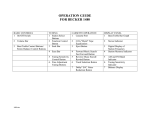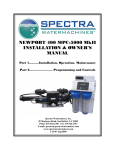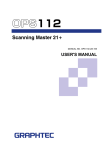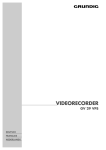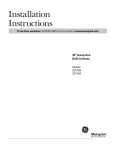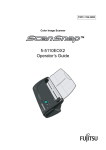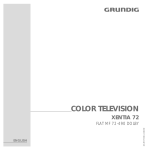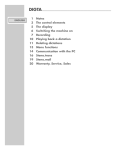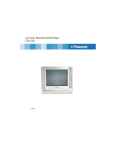Download Grundig World Receiver Yacht Boy 400 User's Manual
Transcript
WORLD RECEIVER YACHT BOY 400 YACHT BOY 400 SLEEP TIME I 60 FM TUNING ..5 ...3...4. 0...1...2 ON TIME ON/OFF 89.6 SLEEP STORE FREE TIME 1/2 MHz AUTO TUNING FM AM 3 2 1 MEMO 4 5 6 7 8 9 RESET 0 FREQU./METER LOCK 4 0 S T A T I O N E S M E M O R I S SB LW / M W / S W /FM STEREO SIZED PLL SYNTHE AUTO TUNING ST E P RSION DUAL CONVE Contents Contents Station Tuning Your Unit at a Glance Frequency Tuning in the FM Band.................................. 15 Frequency Tuning in the AM Band.................................. 15 Station Tuning with the Numeric Buttons ......................... 17 Display ................................................................. 04 Front of Unit............................................................ 06 Top of Unit ............................................................. 08 Right Side of Unit ..................................................... 09 Left Side of Unit ....................................................... 09 Rear of Unit ............................................................ 09 Entering a Meter Band Storing, Calling Up, and Clearing What Can You Store?..................................................20 Checking the Reception Frequency ................................ 20 Creating/Overwriting a Memory Position.......................... 20 Calling Up Stored Stations .......................................... 20 Indicating Free Memory Positions ................................. 21 Clearing a Memory Position......................................... 21 Aerials Power Supply Mains Operation ...................................................... 11 Battery Operation ..................................................... 11 Battery Check .......................................................... 11 Data Protection (Mains and Battery Operation) .................. 12 RESET Button .......................................................... 12 Going to Sleep to Music The Clock Setting the Clock (TIME I) ........................................... 23 Setting the Clock (TIME II) .......................................... 23 Clock Time Indication (TIME I/ II) .................................. 23 General Operation Switching On/Off and Locking ....................................... 13 Direct Entries .......................................................... 13 Display Illumination .................................................. 13 Volume and Tone ..................................................... 14 Waveband Selection.................................................. 14 k1 GB Contents Automatic Switch-On/ Wake-Up Function Entering a Switch-On Time .......................................... 24 Checking the Entered Switch-On Time............................. 24 Wake-Up with Radio/Automatic Switch-On ....................... 24 Wake-Up with Sound Signal/Date Reminder ..................... 25 Clearing the Wake-Up Function..................................... 25 Special Functions on AM SSB Mode (Amateur Radio Reception) ............................ 26 Interferences........................................................... 26 Specification Hints – Prescriptions ................................................. 29 Radio Stations ......................................................... 29 k2 Your Unit at a Glance SNOOZE LIGHT S SB + STORE SSB 0N AUTO FM 1 2 3 AM 4 5 6 7 8 9 s MEMO a TUNING s a RESET 0 LOCK LW / M W / S W / F M S T E R E O k3 FREQU./METER PLL SYNTHESIZED AUTO TUNING OFF FREE ST E P DUAL CONVERSION HIGH TIME 1/2 LOW LOCAL STEREO MONO DC 9V M E M O R I E S ON TIME TONE DX NARR S T A T I O N SLEEP VOLUME SW EXT. ANT. WIDE 4 0 ON/OFF FINE TUNING YACHT BOY 400 °°°°°°°°°°°°°°°°°°°°°°°°°°°°°° °°°°°°°°°°°°°°°°°°°°°°°°°°°°°° °°°°°°°°°°°°°°°°°°°°°°°°°°°°°° °°°°°°°°°°°°°°°°°°°°°°°°°°°°°° °°°°°°°°°°°°°°°°°°°°°°°°°°°°°° °°°°°°°°°°°°°°°°°°°°°°°°°°°°°° °°°°°°°°°°°°°°°°°°°°°°°°°°°°°° °°°°°°°°°°°°°°°°°°°°°°°°°°°°°° °°°°°°°°°°°°°°°°°°°°°°°°°°°°°° °°°°°°°°°°°°°°°°°°°°°°°°°°°°°° °°°°°°°°°°°°°°°°°°°°°°°°°°°°°° °°°°°°°°°°°°°°°°°°°°°°°°°°°°°° °°°°°°°°°°°°°°°°°°°°°°°°°°°°°° °°°°°°°°°°°°°°°°°°°°°°°°°°°°°° °°°°°°°°°°°°°°°°°°°°°°°°°°°°°° °°°°°°°°°°°°°°°°°°°°°°°°°°°°°° °°°°°°°°°°°°°°°°°°°°°°°°°°°°°° °°°°°°°°°°°°°°°°°°°°°°°°°°°°°° °°°°°°°°°°°°°°°°°°°°°°°°°°°°°° °°°°°°°°°°°°°°°°°°°°°°°°°°°°°° °°°°°°°°°°°°°°°°°°°°°°°°°°°°°° °°°°°°°°°°°°°°°°°°°°°°°°°°°°°° °°°°°°°°°°°°°°°°°°°°°°°°°°°°°° °°°°°°°°°°°°°°°°°°°°°°°°°°°°°° °°°°°°°°°°°°°°°°°°°°°°°°°°°°°° °°°°°°°°°°°°°°°°°°°°°°°°°°°°°° °°°°°°°°°°°°°°°°°°°°°°°°°°°°°° °°°°°°°°°°°°°°°°°°°°°°°°°°°°°° °°°°°°°°°°°°°°°°°°°°°°°°°°°°°° °°°°°°°°°°°°°°°°°°°°°°°°°°°°°° °°°°°°°°°°°°°°°°°°°°°°°°°°°°°° °°°°°°°°°°°°°°°°°°°°°°°°°°°°°° °°°°°°°°°°°°°°°°°°°°°°°°°°°°°° °°°°°°°°°°°°°°°°°°°°°°°°°°°°°° °°°°°°°°°°°°°°°°°°°°°°°°°°°°°° °°°°°°°°°°°°°°°°°°°°°°°°°°°°°° °°°°°°°°°°°°°°°°°°°°°°°°°°°°°° °°°°°°°°°°°°°°°°°°°°°°°°°°°°°° Your Unit at a Glance Display ON-TIME 8 8:8 8 BATT. CHECK TIME II FM LW MW SW SLEEP MEMORY STEP 88:88 BATT. CHECK TUNING 0 ... 1 .. .2 ... 3 ... 4 ... 5 IIIIIIIIIIIIIIIIIIII TIME II Time I/II You can select between two times (2 different time zones). Indication of the respective time: – In the left numeric block with the radio switched on. – In the large numeric block with the radio switched off. SLEEP Sleept time A sleep time (operating time) is entered (10, 20, 30, 40, 50 or 60 minutes). When entering the time, it will briefly be indicated in the left numeric block. LOCK When this indication is visible, all buttons are locked, except – the ¢ ON/OFF button (this can further be used to switch off the radio); – the ¶ SNOOZE button (the functions of this button are retained). kHz MHz kHz 8 8 mFREE Optimum read-off quality will be obtained when the set is brought into a tilted position. For this, use the swing-out support at the back of the unit. ON-TIME Wake-up mode symbols You can select the wake-up mode (radio ¤ or sound signal â ) by pressing the ¢ AUTO button. LOCK : 8.8.8.8.8 TUNING 0...1...2...3...4...5 ¤â Wake-up time/switch-on time If ON-TIME is indicated, the wake-up time is shown below (in the left numeric block). Left numeric block a. With radio switched on: 1) Clock time indication (TIME I or TIME II). 2) Wake-up time indication (can be called up by pressing the ¢ AUTO button). 3) Sleep time indication. b. With radio switched off: Wake-up time indication. Battery check When this indication appears, the batteries should be replaced. Tuning/field strength indication The reception quality corresponds to the length of the tuning bar. k4 Your Unit at a Glance ) FM LW MW SW kHz MHz Stereo Indication in the case of stereo broadcasts. 8.8.8:8.8 Indication of the waveband (FM/LW/MW/SW) and the frequency. The associated numeric value is indicated in the large numeric block. 88 Bottom numeric block With the radio switched off: Seconds indication. With the radio switched on: See following description. 88 FREE MEMORY STEP 88 88 kHz 88 m k5 Large numeric block With the radio switched on: Frequency indication and special messages (e.g., E F F 8 F ). With the radio switched off: Time 1 or time 2 (e.g., 2 : 0 4 ). Free memory position Indicates the number of a free memory position. Memory position Indicates the number of the memory position on which the stored frequency is currently received. Tuning step Indicates the width of the manual tuning steps in the AM wavebands (1, 5, 9 or 10 kHz). Meter band indication Indicates the number of the meter band selected. Your Unit at a Glance Front of Unit ON TIME Switch-on time For calling up the wake-up time (in the left numeric block) when the radio is switched on. For setting the wake-up time (switch-on time) (e.g., 7 . 3 0 ON-TIME = 7:30). TIME 1/2 Time I/II For selecting between Time I and Time II. For setting and calling up the times I and II, e.g., 2 1 . 4 0 TIME I/II or TIME I/II 2 1 . 4 0 TIME I/II. FREE Free Indicates free memory positions in increasing order. Two successive pressures on this button will clear occupied memory positions (e.g., 4 FREE FREE). STORE Store in memory You can store in memory up to 40 stations. To avoid redundant storing, first check whether the currently received station has already been stored. If the station has not yet been stored, enter the number of the desired memory position and store the station in memory by pressing the STORE button (e.g., 1 3 STORE). If the selected memory position is not free, the indication will flash for approx. 5 seconds. The memory position will not be overwritten. Multifunction display (Description see further up) ON/OFF On/off button For switching the unit on and off. You can switch the unit off even if all buttons are locked (in LOCK position). SLEEP Sleep button For entering a time after which the unit is switched off (sleep time). Initial value: 60 minutes. This value is decreased in steps of 10 minutes by repeatedly pressing this button. The following order is run through: 60 / 50 / 40 / 30 / 20 / 10 / Radio off / Radio on for 60 min. / 50 ... . Short pressure on the ¢ SLEEP button: Indication of the remaining sleep time for approx. 5 seconds in the display (left numeric block). AUTO AUTOMATIC button For switching between the three function modes: – Wake-up with radio. The display indicates ¤. – Wake-up with sound signal (also with switched-on radio). The display indicates â . – Wake-up function off. When switching to this function, the display (left numeric block) indicates for approx. 5 seconds "-:--". k6 Your Unit at a Glance Two pressures on the button will overwrite occupied memory positions (e.g., 23 STORE STORE): The selected memory position is overwritten and occupied by the station currently tuned to. FM AM RESET LOCK Key lock For locking all keys except the ¢ ON/OFF button (for switching off) and the ¶ SNOOZE button. . Numeric buttons and decimal point 0 ... 9, ¢ VHF For selecting the desired FM (VHF) band. You will hear the last station tuned to in this waveband (Last Station Memory). For clearing incorrect numeric entries. For direct numeric entries. Two pressures on this button will clear incorrect numeric entries. FREQU./METER For entering frequencies (e.g., 1 0 7 . 7 FREQU./ METER = FM 107.7 MHz). For entering meter bands (e.g., 1 3 FREQU./METER = 13 m). AM For switching to the AM wavebands. Repeated pressures on this button will select the wavebands in the following order: LW – MW – SW – LW – MW – etc. You will hear the station last received in the respective waveband (Last Station Memory). For clearing incorrect numeric entries. MEMO w For clearing all stored data (memory positions, clock time). For resetting an eventually blocked keyboard (e.g., after static charges). k7 For calling up the memory positions 1 ... 40 (e.g., 2 0 MEMO w = call-up of memory position 20). Press once: Next higher memory position. Press and keep pressed longer than 1 s: Automatic memory position selection in ascending order. The automatic memory position select function stops for approx. 5 seconds on each memory position so that the station received on it can be checked. A further pressure on the MEMO w button will terminate this function. Your Unit at a Glance MEMO q For calling up the memory positions (as with MEMO w). Press once: Next lower memory position. Press and keep pressed longer than 1 s: Automatic memory position selection in descending order. The automatic memory position select function stops for approx. 5 seconds on each memory position so that the station received on it can be checked. A further pressure on the MEMO q button will terminate this function. Top of Unit Telescopic aerial for FM and SW reception. SNOOZE Snooze button Press once to switch off the radio or the alarm function after wake-up. After five minutes, the wake-up function will be repeated (sound signal or radio). Keep pressed the button longer than 2 seconds to switch off the wake-up function. The function will be retained for the following day(s). If the SNOOZE button is not pressed, the sound signal will sound for 5 minutes or the radio play for 60 minutes. After that, the respective function will be switched off. LIGHT Display illumination TUNING w / q For manual step-by-step tuning in direction of higher or lower frequencies. Keep button pressed: Frequency scan up or down. STEP For selecting the manual tuning steps (the respective waveband must have been selected). LW 1 kHz or 9 kHz SW 1 kHz or 5 kHz MW 1 kHz or 9 kHz resp. 10 kHz For selecting the tuning step 9 kHz or 10 kHz in the MW band, the unit must be switched off with the ¢ ON/OFF button. Press this button to illuminate the display. After 10 seconds, the illumination will automatically be switched off. The duration of the display illumination will be increased if any other button will be pressed within this 10-seconds period. A pressure on the ¢ LIGHT button will immediately switch off the display illumination. AUTO TUNING Automatic station tuning Press briefly: Automatic station tuning in direction of higher frequencies. Keep pressed longer then 0.5 s: Automatic station tuning in direction of lower frequencies. k8 Your Unit at a Glance STEREO MONO On FM: Mono/stereo switch. WIDE NARR On AM: Wide/narrow switch. In the FM waveband, this switch is used to select between mono and stereo reception. In the AM wavebands, the same switch is used for changing the bandwidth. Right Side of Unit FINE TUNING Fine tuning For fine tuning on SSB reception. SSB SSW on/off switch For switching on and off the SSB mode (Single Side Band reception). U SSB is especially used for amateur SW radio reception. TONE Tone control Y DC 9V Two positions: HIGH (treble) and LOW (bass). VOLUME Volume control Left Side of Unit SW EXT.ANT Socket for external aerial Aerial connection for SW reception. For external aerial with 3.5 mm ø jack plug. DX/LOCAL Sensitivity switch Normal position is "DX" (distant reception). If the signal is too strong resulting in reception interferences, set the switch to "LOCAL". Headphone/earphone socket For headphone or earphone with jack plug of 3.5 mm ø (32 Ohm impedance). Connecting a headphone disconnects the built-in loudspeaker. For this reason, the headphone must be disconnected if you wish to be woken up by the radio. DC socket For connecting a commercial plug-in mains unit with coaxial plug (outer diameter 5.5 mm, inner diameter 2.1 mm; output voltage 9.0 V=; mains voltage 230 V ¦, 50/60 Hz; neutral conductor connected to earth ). Y Rear of Unit Swing-out support Swing out this support to bring the unit into a tilted position. On the support there is an illustration showing the time zones of the earth. Below the support there is the type plate of the unit. Battery compartment For six 1.5V batteries (IEC LR6, UM-3). k9 Aerials Telescopic aerial for FM and SW reception. When the aerial base is completely retracted, the telescopic aerial can be tilted and swivelled into the position giving best reception. For SW reception, fully extend the aerial and position it vertically. Due to the much better propagation conditions in the evening and night hours with respect to daytime reception, interferences may occur during these hours. These interferences can be reduced by partially pushing in the telescopic aerial. Please note: Touching the telescopic aerial will affect the FM and SW reception quality. Ferrite rod aerial for MW and LW reception (built-in). Turn the unit about its vertical axis to find the position giving best reception. k 10 Power Supply Mains Operation Battery Check Y Only use a mains unit with the correct output voltage of 9V = and correct polarity . When the batteries get weak, the indication the display. Connect the mains unit to the DC 9V socket. This disconnects the inserted batteries. When the radio is switched on, it will switch off after a short time. ON-TIME 8 6:3 0 No responsibility can be accepted for damage due to incorrect mains operation. BATT. CHECK Remove the batteries if you intend to operate the unit permanently on the mains! BATT. CHECK will flash in TIME I : 8.I.8.0.0 00 Attention Remove exhausted batteries immediately from the unit! Battery Operation with six 1.5 Volt batteries, type IEC LR 6 / UM-3/AA. We recommend the use of alkaline-manganese batteries with low mercury percentage or no mercury at all. Disconnect the plug of the mains unit from the DC 9V socket. If the unit is not to be used for long periods, also remove new batteries! No responsibility can be accepted for damage caused by leaking batteries. Open the cover of the battery compartment (at back of unit). Protect the Environment! Insert batteries with correct polarity (see scheme above battery compartment). Do not throw exhausted batteries in the household waste! When buying new batteries, hand over the old ones to your radio dealer or a special collecting point. Observe correct order of batteries when fitting them. k 11 Power Supply Data Protection (Mains and Battery Operation) The data stored in the station memory, the clock time, and the Last Station Memory are retained for approx. 10 minutes. You can calmly exchange the batteries without being afraid of loosing the stored data. RESET Button If, due to external interferences (caused by static charges of carpets, thunderstorms, etc.), the control electronics of your Yacht Boy 400 should receive bad information signals, or if no entries at all are possible, press the ¢ RESET button. This is to be found between the ¢ AM and the ¢ LOCK button. For pushing this button, it is best to use a bent-up paper clip. This releases the RESET impulse which in turn resets the unit to its initial programming state. The stored data for the individual station memory positions, the clock time and the last station memory is cleared. When the power supply is interrupted, the stored stations and menu options are retained for approx. 10 minutes. k 12 General Operation For convenient operation, your Yacht Boy can be brought into a tilted position by the swing-out stand provided at its rear. The type plate is to be found below this stand. On the stand, there is an illustration showing the time zones of the world. Button pressure times Brief: less than 0.5 seconds. Long: more than 0.5 seconds. Switching On/Off and Locking To switch the unit on and off, press the ¢ (ON/OFF) button (with the LOCK not being activated, see below). Locking With the unit being switched on or off, you can lock the function buttons at the front of the unit by pressing the ¢ LOCK button. The buttons are thus protected against inadvertent operation (indication LOCK in display). To unlock the buttons, press the LOCK button once again. TIME I I 8:0 0 BATT. CHECK FM LW MW SW For entering numeric values, use the numeric buttons. These values are: Frequencies, station position numbers (programming and calling up), SW meter bands, clock times, and switching times. For each data entry (pressure on a button), you dispose of up to approx. 5 seconds. When this time has elapsed, you must re-enter the whole numeric value. To immediately correct bad entries which have not yet been concluded, press the FM or AM button, or press twice the "." button (decimal point) of the numeric buttons. If you should make a bad entry or operation, the error message E F F 8 F will appear in the display. Display Illumination Pressing the ¶ LIGHT button switches on the display illumination for approx. 10 seconds. If you press a button of the unit, this illumination time will be increased. LOCK 8.9.8.6.0 Direct Entries If you wish to immediately switch off the display illumination, press the ¶ LIGHT button once again. kHz MHz TUNING 0...1...2...3...4...5 k 13 General Operation Volume and Tone The volume is adjusted with the VOLUME control. The tone is adjusted with the TONE switch. LOW = Bass. HIGH = Treble. Waveband Selection After switching on the unit with the ¢ ON/OFF button, it is ready for reception and you hear the station last tuned to. FM The FM (VHF) band is selected with the ¢ FM button. AM The AM bands are selected with the ¢ AM button. The first pressure on the ¢ AM button switches to the station last received on one of the AM bands. Each further pressure on the bands in the order ¢ AM button steps through the AM LW / MW / SW / LW / MW / etc. and you will hear the station last tuned to in the selected band. k 14 Station Tuning Switch the unit on with the ¢ ON/OFF button. The display indicates the frequency tuned to – on FM in MHz, and on AM in kHz. The automatic search will stop as soon as it has found a station worthy of reception (of a signal strength sufficient for good reception). It then can be restarted with the ¢ AUTO TUNING button (brief or long pressure). TIME I Frequency Tuning in the FM Band I 8:0 0 Select the FM band. You hear the station last tuned to in the FM band. BATT. CHECK FM LW MW SW : 8.9.8.6.0 kHz MHz TUNING 0...1...2...3...4...5 Manual tuning Tune to the desired station by briefly pressing one of the buttons TUNING w or TUNING q . Each button pressure will change the frequency by 50 kHz. If the TUNING w or TUNING q button is kept pressed, the frequency range will be sanned in 50 kHz steps at high speed until the respective button is released. 0 0 Automatic tuning (AUTO TUNING) This frequency search is started by pressing the ¢ AUTO TUNING button. Short presssure: Search is started in direction of higher frequencies. Long pressure: Search is started in direction of lower frequencies. The search function operates with 50 kHz steps. Frequency Tuning in the AM Bands Select the AM range. You will hear the station last tuned to in the respective AM band. Selecting an AM band Press the ¢ AM button repeatedly until the desired AM band is selected. This is indicated in the display. Each pressure on the button steps through the AM band in the order LW / MW / SW / LW / MW / etc. k 15 Station Tuning Adjusting the tuning steps The tuning steps are adjusted with the ¢ STEP button. With the unit switched on, you can switch between: 1 kHz or 9 kHz on LW 1 kHz or 5 kHz on SW 1 kHz or 9 resp. 10 kHz on MW. The respective waveband must be selected. Repeatedly press the ¢ STEP button until the desired tuning step value (e.g., in the figure, STEP 9KHZ) is indicated in the display. TIME I I 8:0 0 BATT. CHECK FM LW MW SW TUNING 0...1...2...3...4...5 8.8.I.5.3 MEMORY STEP kHz MHz kHz 8 9 mFREE With the unit switched off, you can switch between the tuning steps 9 kHz and 10 kHz (for USA radio stations) in the MW band. If the unit is not yet switched off, do this. Press the AM button, then repeatedly press the ¢ STEP button until the desired step value is indicated in the display. After approx. 5 seconds, the display will indicate again the clock time. This is a precaution to avoid accidental tuning step switching. ON-TIME 8 6:3 0 TIME I FM LW MW SW 8.8.8.I.0 kHz MHz 00 When activating the automatic tuning mode, the unit automatically switches to the higher tuning step. However, the 9 kHz or 10 kHz choice in the MW band is retained. Manual tuning – Tune to the desired station by briefly pressing on the TUNING w or TUNING q button. Each pressure on the button performs a tuning step of the value adjusted for the respective waveband (FM: 50 kHz, AM: see chapter "Adjusting the tuning steps"). – When keeping pressed the TUNING w or TUNING q button, the respective waveband will be scanned at high speed with the tuning steps selected for it. Releasing the pressed button will stop scanning. 0 0 You can switch between 5 kHz and 10 kHz tuning steps – as soon as the AM button has been pressed after switching off the unit, – until you switch the unit on again. k 16 Station Tuning Automatic tuning (AUTO TUNING) This frequency search is started by pressing the ¢ AUTO TUNING button. Short presssure: Search is started in direction of higher frequencies. Long pressure: Search is started in direction of lower frequencies. The search function operates with the tuning steps 9 kHz on LW, 5 kHz on SW, 9 or 10 kHz on MW. Station Tuning with the Numeric Buttons (Direct frequency entry) For this, the frequency of the station you wish to tune to must be known. You can find these frequencies in station tables or radio guides. You can enter the frequency in MHz or kHz, or as meter band on SW. Confirm the entries with the ¢ FREQU./METER button. If a lower step value has been adjusted, the unit will automatically select the tuning steps indicated above. For 9 kHz/10 kHz switching on MW, see chapter "Adjusting the tuning steps", page 16. The automatic search will stop as soon as it has found a station with sufficient field strength for good reception. It can then be restarted with the ¢ AUTO TUNING button (brief or long pressure). On FM: MHz indication. On AM: kHz indication. Examples: Desired frequency Entry order 99.00 MHz 99.00 MHz 99.00 MHz 99.10 MHz 99.10 MHz 99.10 MHz 7000 kHz 99. /¢ 99.0 / ¢ 99.00 / ¢ 99.1 / ¢ 99.10 / ¢ 99.100 / ¢ 7000 / ¢ FREQU./METER button FREQU./METER button FREQU./METER button FREQU./METER button FREQU./METER button FREQU./METER button FREQU./METER button It is absolutely necessary to enter the decimal point, even if no further figures follow. The decimal point is the indication that the entry is made in MHz. Without decimal point, the entry is interpreted as kHz entry. k 17 Entering a Meter Band Entering a meter band on SW Entered numbers below 100 with subsequent confirmation by the ¢ FREQU./METER button are interpreted as wavelength in meter for SW. If the entry is valid, a frequency next to the band centre will be tuned to in the case of radio bands, and the beginning of the respective SW band in the case of amateur bands. See table on page 19. It is possible to enter the following meter bands: 10, 11, 12, 13, 15, 16, 17, 19, 20, 22, 25, 30, 31, 40, 41, 49, 60, 75, 80, 90. Indication of the current band on SW In the case of direct frequency entry or SW frequency scanning (within a m-band): The selected band is permanently indicated. In the case of direct frequency entry or manual tuning: If the frequency tuned to lies within one of the above indicated bands, this band will permanently be indicated in the display. If the entry made is invalid, the indication " E F F 8 F appears for approx. 5 seconds in the display. Entry example for the 49-m band: Numeric buttons 4 9, button ¢ FREQU./METER / 6075 kHz (= Deutsche Welle). TIME I I 8:0 0 BATT. CHECK FM LW MW SW 8.6.0.7.5 TUNING 0...1...2...3...4...5 kHz MHz kHz 4 9 mFREE k 18 Entering a Meter Band Band (m) Lower cut-off frequecy (kHz) Radio station* or band centre 90-m tropic 80-m amateur 75-m radio 60-m tropic 49-m radio 40-m amateur 41-m radio 31-m radio 30-m amateur 25-m radio 22-m radio 20-m amateur 19-m radio 16-m radio 17-m amateur 15-m amateur 13-m radio 12-m radio 11-m radio 10-m amateur 3200 3500 3900 4750 5950 7000 7100 9500 10100 11650 13600 14000 15100 17550 18065 21000 21450 24890 25650 28000 3300 3955 4905 6075 7200 9635 11845 13700 15320 17705 21690 25820 * Not all radio stations are broadcasting 24 hours the day and during all seasons a programme on this frequency. For this reason, consider the different broadcasting times. k 19 Storing, Calling Up, and Clearing What Can You Store? You can programme up to 40 station memory positions (memory positions 1 ... 40) in random order, also mixed from the 4 wavebands FM-MW-LW-SW. You can store in memory each frequency tuned to. If the memory position is alread occupied, – the frequency indication flashes in the display. The indications "MEMORY" and the number of the selected memory position remain steady. – If you press the ¶ STORE button a second time within 5 seconds, the memory position will be overwritten, otherwise it remains unchanged. Checking the Reception Frequency You can check whether a frequency is already stored on one of the memory positions. Tune to the desired frequency. Press the ¶ STORE button a long time. The indication "MEMORY" appears in the display. The unit checks whether the frequency is already stored. If yes, the display indicates "MEMORY" and the number of the memory position on which the frequency is stored. If no, the indication "MEMORY" disappears from the display. Creating/Overwriting a Memory Position Tune to the station concerned. Check whether the frequency is already stored in memory. Enter the number of the desired memory position with the numeric buttons (the number appears in the display). Press the ¶ STORE button (within 5 seconds). If the memory position is free, – the display indicates "MEMORY", the number of the selected memory position, and the frequency of the station tuned to. TIME I I 8:0 0 BATT. CHECK FM LW MW SW TUNING 0...1...2...3...4...5 I.0.2.0.0 MEMORY STEP kHz MHz 07 Calling Up Stored Stations Direct entry Enter the number of the desired memory position. Briefly press the ¢ MEMO w or MEMO q button. If the memory position is occupied, – the unit automatically tunes to the station in the respective waveband. – The display indicates the frequency of the station. – The display indicates "MEMORY" and the number of the memory position. If the memory position is free, the display indicates for approx. 5 seconds "MEMORY", the number of the memory position, and "FREE". k 20 Storing, Calling Up, and Clearing Memo buttons TIME I A short pressure on the ¢ MEMO w button calls up the next higher memory position. The unit automatically tunes to the corresponding station in the correct waveband. I 8:0 0 BATT. CHECK Long pressure on the ¢ MEMO q button: – All occupied memory positions are scanned in descending order. – Each station remains tuned to for approx. 5 seconds before the unit goes to the next one. – A further pressure on the ¢ MEMO q button stops scanning. Indicating Free Memory Positions A pressure on the ¶ FREE button will indicate the first free memory position in the display. 8.9.8.6.0 TUNING 0...1...2...3...4...5 A short pressure on the ¢ MEMO q button calls up the next lower memory position. The unit automatically tunes to the corresponding station in the correct waveband. Long pressure on the ¢ MEMO wbutton: – All occupied memory positions are scanned in ascending order. – Each station remains tuned to for approx. 5 seconds before the unit goes to the next one. – A further pressure on the ¢ MEMO w button stops scanning. FM LW MW SW MEMORY 3I kHz MHz FREE m kHz Clearing a Memory Position Enter the number fo the desired memory position with the numeric buttons (the number is indicated in the large numeric block in the display). Press the ¶ FREE button. If the memory position is free, – the display indicates "MEMORY", the number of the selected memory position, and "FREE". If the memory position is occupied, – the display indicates "MEMORY" and the number of the selected memory position. – The frequency indication is flashing in the display. If you press the ¶ FREE button within 5 seconds a second time, the contents of the memory position will be cleared. Each further pressure on the ¶ FREE button will indicate the next free memory position in upward direction. k 21 Going to Sleep to Music You can enter a time period (60 minutes max.), after which the radio switches automatically off. When the programmed switch-on period has elapsed, the unit is switched off and the SLEEP indication goes out. Press the ¢ SLEEP button. When the radio was switched off, it will be switched on. The further procedure is independent of whether the radio was switched off or not. The switch-on period (period until the radio is switched off) is 60 minutes. The display indicates for approx. 5 seconds the remaining switch-on period. It indicates in addition SLEEP to signal that the "automatic switch-off function" is activated. Checking the switch-on time: TIME I 60 BATT. CHECK FM LW MW SW Briefly press the ¢ SLEEP button. The display indicates the time left till the automatic switch-off. Clearing the switch-on period prematurely: Switch off the unit with the ¢ ON/OFF button or press the ¶ SNOOZE button. SLEEP 8.9.8.6.0 kHz MHz TUNING 0...1...2...3...4...5 Repeated pressures on the ¢ SLEEP button will reduce the switchon period in steps of 10 minutes. Each time the ¢ SLEEP button is pressed, the display indicates for approx. 5 seconds the remaining switch-on time. When pressing the ¢ SLEEP button has reduced the switch-on period to 0 second, the unit switches off. A further pressure on the ¢ SLEEP button switches the radio on again and the initial switchon time of 60 minutes is selected. Repeated pressures on the ¢ SLEEP button give the following order: 60 / 50 / 40 / 30 / 20 / 10 / off / 60 / 50 / ... The numbers indicate the minutes left till the automatic switch-off. k 22 The Clock Here too, each entry step (button pressure) must be completed within a period of 5 seconds. You can enter clock times no matter whether the unit is switched on or off. There are several possible methods for entering clock and switching times. Setting the Clock (TIME II/Clock Time II) For setting TIME II follow the same steps, except that the display must indicate TIME II. As the seconds of TIME II are running synchronously with the seconds of TIME I, it is not necessary to wait until the minute changes. Examples: Clock time Possible entries 1st example: Clock time 6.30 2nd example: Clock time 15.00 3rd example: Clock time 0.15 Clock Time Indication (TIME I/II) 6.30 06.30 15. 15.00 .15 0.15 00.15 You can switch between the indications of the two clock times by pressing the ¶ TIME I/II button (no numeric entry beforehand). ON-TIME 8 6:3 0 TIME II : 8.I.6.0.0 00 Setting the Clock (TIME I) Setting TIME I with the help of a reference clock. Example TIME I: 6.30 h The display must indicate TIME I. Enter the clock time with the numeric buttons immediately before the reference clock changes from 6.29.59 to 6.30.00. The period between the last entry and 6.30.00 must not exceed 5 seconds. Press the ¶ TIME I/II button at the moment when the reference clock jumps from 6.29.59 to 6.30.00. When pressing the ¶ TIME 1/2 button, the clock is started exactly to the second and the minutes indication will flash. k 23 Automatic Switch-On/Wake-Up Function Your radio allows you to enter a wake-up time (switch-on time). ¤ = Wake-up with radio programme. When selecting the function "Wake-up with radio", you will hear the last received radio station. The switching times refer to the clock time (TIME I or TIME II) indicated in the display. You hear the station last tuned to. = Wake-up with sound signal. The radio is muted and you hear a sound signal instead. This function is also possible with the radio switched on, e.g., to remind you at a date. -:-- = Wake-up function switched off. Example: â You have entered the local time (e.g., CET or CEST) as TIME I. TIME II stands for a second time zone (e.g. Greenwich Mean Time /GMT). You have entered 14.00 h as switch-on (wake-up) time and activated the wake-up function. If the display indicates TIME I, the unit will be switched on at 14.00 h local time; if the display indicates TIME II, the unit will be switched on at 14.00 h of the second time zone. Entering a Switch-On Time ON-TIME 8 6:3 0 TIME I : 8.I.8.0.0 00 Checking the Entered Switch-On Time When the radio is switched off, the display indicates the switch-on time and the wake-up mode. Switch on the radio. Enter the desired switch-on (wake-up) time with the numeric buttons 0 ... 9. Press the ¶ ON TIME button to store the entered switch-on time in memory. The switch-off time is automatically set to one hour after the switchon time. Select the desired wake-up mode by repeated pressures on the ¢ AUTO button. Wake-Up with Radio/Automatic Switch-On Select "Wake-up with radio" (symbol ¤ in display) with the ¢ AUTO button. Adjust the wake-up time. Before switching off the radio, tune to the station and adjust the volume with which you wish to be woken up. Switch off the radio. k 24 Automatic Switch-On/Wake-Up Function At the programmed time, the radio is automatically switched on. If no button is pressed, the radio will play for about 60 minutes and then is switched off automatically. If you press the ¶ SNOOZE button, the radio is switched off for 5 minutes and the ¤ symbol is flashing in the display. You can repeat this snooze function as often as desired. If you press the ¶ SNOOZE button longer than 2 seconds, the radio is completely switched off. The ¤ symbol is permanently indicated. The wake-up function is repeated next day. Clearing the Wake-Up Function Switch off the wake-up function with the ¢ AUTO button (the symbols ¤ and â must disappear from the display). When the radio is switched off – ON-TIME is not visible in the display. – The indication -:-- appears instead of the programmed wake-up time in the left numeric block in the display. The programmed wake-up time remains stored in memory. Wake-Up with Sound Signal (Date Reminder) Select "Wake-up with sound signal" (symbol â in display) with the ¢ AUTO button. Adjust the wake-up time. "Wake-up with signal sound" is possible, if – the radio is switched off (wake-up), – the radio is switched on (date reminder). The radio is automatically switched off and the sound signal is started. If no button is pressed, the sound signal will last 5 minutes. If you press the ¶ SNOOZE button, the alarm sound will be switched off for about 5 minutes and the â symbol is flashing in the display. The snooze function can be repeated as often as desired. If you press the ¶ SNOOZE button for more than 2 seconds, the alarm sound is completely switched off. The â symbol is permanently visible and the wake-up function will be repeated next day. k 25 Special Functions on AM SSB Mode (Amateur Radio Reception) SSB reception is an additional function to "normal" radio reception. It allows you to listen to amateur transmissions (mostly speech). In most cases, these are transmitted in the SSB mode (Single Side Band). Proceed as follows: Switch the unit on and select a SW amateur band (see table in chapter "Entering a Meter Band"). Set the switch STEREO MONO WIDE NARR As soon as a station is found – the speech is still unintelligible – tune to best possible reception with the help of the FINE TUNING control. When arriving at the limit of the finetuning range, it may be necessary to TUNING w and switch to the next tuning range by means of the TUNING q buttons. 0 If you wish to terminate reception of SSB stations, do not forget to switch back to normal radio reception: DX LOCAL switch to DX. SSB switch to OFF. STEREO MONO WIDE NARR switch to STEREO. TONE switch as desired. to NARR(OW). Set the SSW switch ton ON. Use the ¢ STEP button to adjust the tuning step to 1 kHz. Set the TONE switch to HIGH. TUNING w and TUNING q buttons to slowly scan the Use the band step by step for SSB stations. 0 Interferences If interferences should occur in the AM bands (MW, LW, SW), you can optimize reception with the FINE TUNING control. When doing this, consider that the carrier is suppressed on SSB broadcasts. This means that reception is only possible when the transmitter is actually broadcasting (mostly in speech). The TUNING indication is of great help when searching SSB stations. The TUNING indication deflects in the rythm of the speech. k 26 Specification Power Supply By six 1.5 V batteries (IEC LR 6). External supply: By a commercial 9 V DC mains unit (see connecting socket). Output Power 600 mW (via built-in loudspeaker). Built-in Aerials Telescopic aerial for FM and SW. Ferrite rod aerial for MW and LW. Connecting Sockets For external voltage supply: DC 9V. Coaxial socket (outer diameter 5.5 mm, inner diameter 2.1 mm). Neutral concuctor connected to chassis . For earphone/headphone U. Socket for jack plug of 3.5 mm ø, 32 Ohm impedance. Y For external aerial EXT ANT. Socket for jack plug of 3.5 mm ø, for shortwave reception. k 27 Specification Wavebands FM: 875 ... 108 MHz SW: 1.711 ... 30 MHz 3.95 ... 26,1 MHz (Yacht Boy 400 IB) MW: 520 ... 1710 kHz 527 ... 1606 kHz (Yacht Boy 400 IB) LW: 144 ... 353 kHz 149 ... 283 kHz (Yacht Boy 400 IB) Tuning Steps FM: 50 kHz SW: 1 kHz / 5 kHz MW: 1 kHz / 9 bzw. 10 kHz LW: 1 kHz / 9 kHz Fine tuning on SSB: ± 1 kHz Intermediate Frequencies FM: 10.7 MHz AM: ZF 1: 55.85 MHz, ZF 2: 455 kHz Receivable SW bands Band Frequency (kHz) 90-m tropical 80-m amateur 75-m radio 60-m tropical 49-m radio 41-m radio 40-m amateur 31-m radio 30-m amateur 25-m radio 22-m radio 20-m amateur 19-m radio 17-m amateur 16-m radio 15-m amateur 13-m radio 12-m amateur 11-m radio 10-m amateur 3200 3500 3900 4750 5950 7100 7000 9500 10100 11650 13600 14000 15100 18065 17550 21000 21450 24890 25650 28000 – – – – – – – – – – – – – – – – – – – – 3400 (not with YB 400 IB) 3800 (not with YB 400 IB) 4000 5060 6200 7300 7099 9900 10150 12050 13800 14350 15600 18170 17900 21449 21850 24990 26100 29700 (not with YB 400 IB) Dimensions: approx. 180 x 120 x 37 mm3 (width x hight x depth) Weight: approx. 590 g Subject to technical alterations and alterations in styling. E. and O. E. k 28 Specification Hints – Prescriptions Use only a soft cloth which picks up dust to clean the cabinet. Do not use aggressive polishes or cleaning agents. Do not expose the set to temperatures above 60°C. In the case of defects, consult your specialized dealer. Protect the unit against any moisture (e.g. dripping or splashing). Radio France Internationale 116 av. du Pres. Kennedy F 75786 Paris Cedex 16 Radiotelevisione Italiana Viale Mazzini 14 I-00195 Roma The unit meets the CEE regulations concerning interference radiation. BBC London External Services Bush House London WC2B 4PH The unit complies with the safety regulations according to VDE 0860/ BS 415 and thus with the international safety regulations according to IEC65. Radio Moscow Pjatnizkaja 25 Moskva Russische Föderation Radio Stations Deutsche Welle D-50588 Köln Radio Exterior de Espana P. O. Box 156.202 E-28080 Madrid Radio Austria International A-1136 Wien Würzburggasse 30 Swiss Radio International CH-3000 Bern 15 Giacomettistr. 1 Radio Nederland P. O. Box 222 NL-1200 JG Hilversum k 29 k 30 Grundig AG • Beuthener 41 • D-90471 Nürnberg • http://www.grundig.com GRUNDIG AG • Kurgartenstraße 37 •Str. D-90762 Fürth • http://www.grundig.de • http://www.grundig.com 737 7100 7100 72010 737
































